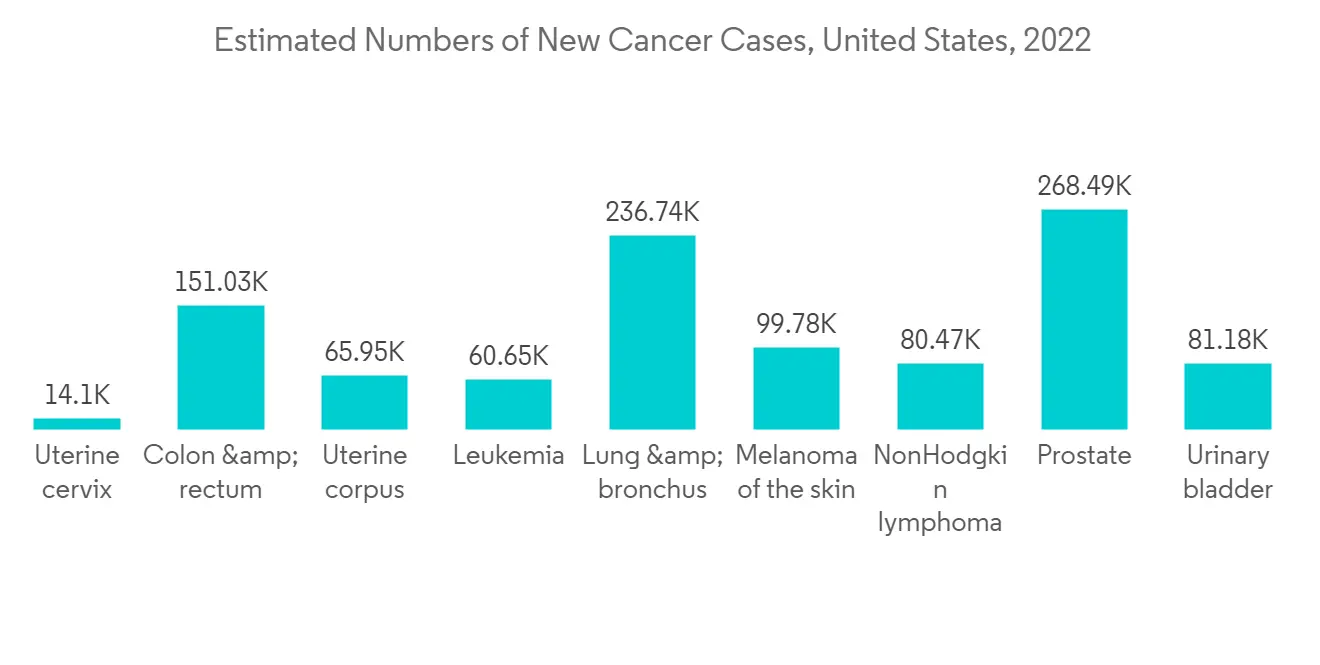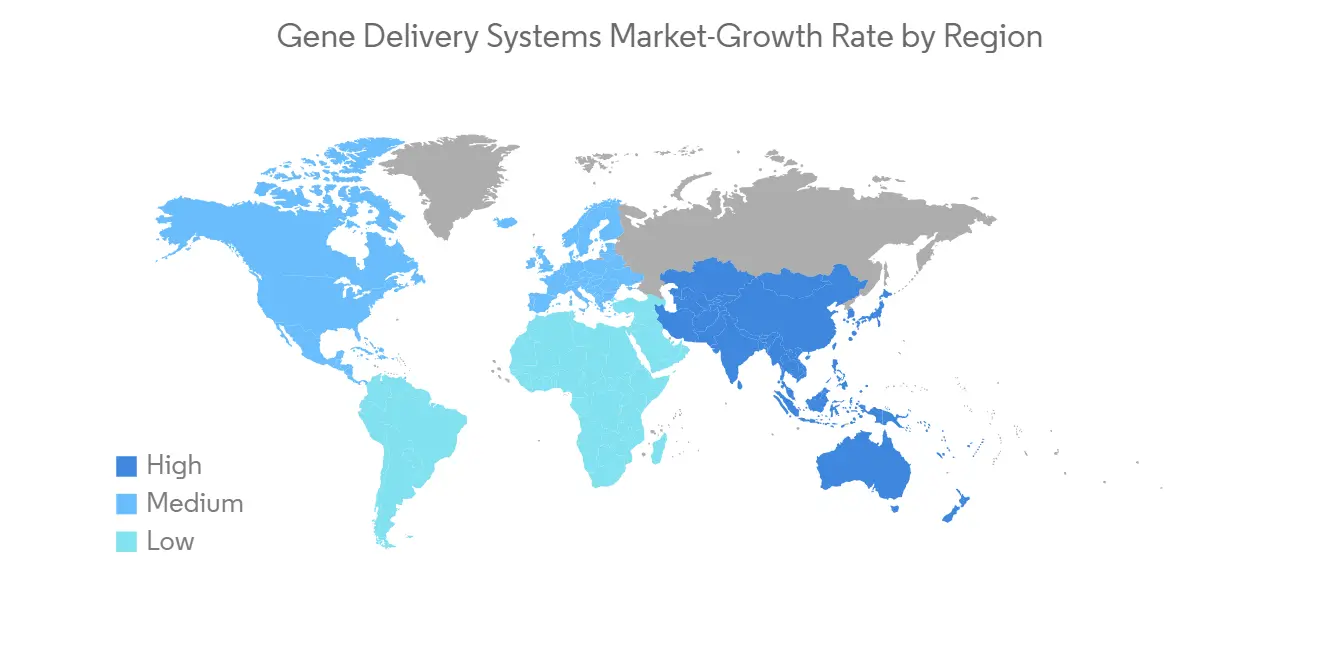 |
市場調査レポート
商品コード
1273341
遺伝子導入システム市場- 成長、動向、予測(2023年-2028年)Gene Delivery Systems Market - Growth, Trends, and Forecasts (2023 - 2028) |
||||||
● お客様のご希望に応じて、既存データの加工や未掲載情報(例:国別セグメント)の追加などの対応が可能です。 詳細はお問い合わせください。
| 遺伝子導入システム市場- 成長、動向、予測(2023年-2028年) |
|
出版日: 2023年04月14日
発行: Mordor Intelligence
ページ情報: 英文 110 Pages
納期: 2~3営業日
|
- 全表示
- 概要
- 目次
遺伝子導入システム市場は、予測期間中に7.3%のCAGRで推移すると予測されています。
COVID-19は、遺伝子送達システム市場に大きな影響を与えました。例えば、2021年10月にDrug Discovery Todayが発表した記事によると、COVID-19のパンデミックのために、COVID-19とは無関係の疾患に対する細胞・遺伝子治療(CGT)の研究、生産、臨床開発、市場導入はすべて大きく中断されました。生命を脅かす希少な疾患を適応症とするCGTでは、遠隔医療が臨床試験におけるフォローアップのロスを減らす有力な手段であることが判明しています。さらに、プライム・セラピューティクスは、COVID-19が米国で流行した初期段階で、遺伝子治療再保険製品PreserveRxを発売し、当時利用可能だった唯一の遺伝子治療薬LuxturnaとZolgensmaをサポートしました。プライムは、2021年にバリューベースの成果を得るために、製造元のノバルティスジーンセラピーとの契約を調整しました。さらに、2021年8月、ノバルティスは、米国の規制当局が制限を解除した後、患者1人当たりの治療費が210万米ドルの1回治療であるZolgensmaの使用を拡大するための新しい第3相試験を開始しました。パンデミック時に市場関係者がとったこれらの取り組みを受けて、市場は回復し、予測期間中に力強い成長を示すと予想されます。
市場成長の主な要因は、慢性疾患の発生率と有病率の上昇、ドラッグデリバリーの技術的進歩の増加です。米国などの先進諸国における代表的な慢性疾患には、心血管疾患、感染症、がん、糖尿病などがあります。例えば、米国がん協会の2023年最新情報によると、2023年に米国で新たに200万人のがん患者が診断される可能性があります。さらに、2021年6月に国立医学図書館が発表した論文では、スペインでは、2021年に2型糖尿病患者における心血管疾患の有病率が6.9%から40.8%の範囲で報告されたことが言及されています。同資料によると、冠状動脈性心疾患の有病率は4.7%から37%、脳卒中は3.5%から19.6%、末梢動脈疾患は2.5%から13.0%、心不全は4.3%から20.1%であったといいます。慢性疾患の発症率が高いことから、充実した診断方法の需要が高まり、市場を牽引していると考えられます。
さらに、世界的にゲノミクス分野で進行中の研究開発が増加していることも、予測期間中の市場成長に寄与すると期待されています。例えば、2022年5月、Pell Bio-Med Technology社が製造したレンチウイルスベースの遺伝子編集免疫細胞を受けたことのある患者における安全性と有効性を評価する臨床研究を後援しました。遺伝子導入システム分野におけるこのような研究イニシアチブは、予測期間中の市場成長を後押しすると予測されます。
製品の発売、拡大、パートナーシップなど、主要な市場プレーヤーによるさまざまな取り組みが、予測期間中の市場の成長を後押しすると予想されます。例えば、2021年6月、VIVEbiotech社はスペインに新しいレンチウイルスベクター製造施設を開設し、細胞および遺伝子治療で使用するレンチウイルスベクターの生産能力を拡大しました。このような新興国市場の開拓は、予測期間中の市場の成長を促進すると期待されます。
しかし、治療費の高さが、予測期間中の調査対象市場の成長を抑制すると予想されます。
遺伝子導入システム市場の動向
遺伝子導入システム市場で最大のシェアを占めると予想されるウイルス遺伝子導入システムセグメント
ウイルス遺伝子導入システムは、複製不能に改変されたウイルスで構成されており、遺伝子を細胞に送り込んで発現を提供することができます。ウイルス遺伝子導入システムには、アデノウイルス、レトロウイルス、レンチウイルスが使用されています。ウイルス遺伝子導入システムは、長期発現や短期発現などの属性、治療用遺伝子の有効性、ここ数年の技術の進歩の高まりにより、ヘルスケア産業における多くの成長機会をもたらしていることから、予測期間中に大きな市場シェアを占めると思われます。また、がんや心血管疾患などの慢性疾患の有病率の増加も、市場の成長に寄与しています。例えば、2022年1月に発表されたBritish Heart Foundation England Factsheetによると、イングランドでは約640万人が心血管疾患と共存しています。また、CDCによると、2021年、米国では20歳以上の成人約1,820万人が冠動脈疾患(CAD)を患っています。米国では、心臓病が人々の死因のトップとなっています。したがって、慢性疾患の増加は、調査対象市場の成長を著しく促進することになります。
各国の政府がこれらの治療法について統治し、意識を高めることを重視するようになった結果、これらの遺伝子導入システムが世界中で急速に受け入れられています。例えば、世界経済フォーラムの2022年9月の報告書によると、個別化された遺伝子治療法のユニークな性質は、従来の枠組みの中で規制することを困難にしています。米国では、2030年までに60以上の遺伝子治療が承認される見込みであり、FDAはこれらの新規治療法の安全性と有効性を適切に判断するために迅速な進化を迫られている、と同ソースは述べています。このような規制の変化は世界中に波及し、各国は規制要件の統一を図り、企業が遺伝子治療薬をより早く、より多くの市場に提供することを容易にしています。このような世界の取り組みにより、遺伝子治療の導入が進み、遺伝子導入システムの活用が進み、市場の成長につながるものと思われます。

北米は予測期間中、大幅な市場成長を示すと予想される
北米は、予測期間中、遺伝子導入システム市場全体の優位性を維持すると予想されます。慢性疾患の有病率の上昇、技術的進歩、大手企業の拠点化などの要因が、この地域の市場成長を後押ししています。例えば、米国がん協会が2023年1月に発表したデータでは、2023年に米国で新たに診断されるがん患者は推定1,958,310人とされています。また、米国では、2019年の65歳以上の人口は5,410万人(総人口の16%)であり、2040年には21.6%になると推定されています。
さらに、主要な市場プレイヤーの存在や、パートナーシップや協業など、プレイヤーが実施する主要な戦略も、市場成長に寄与しています。例えば、2021年6月のニュース報道によると、カナダ保健省は5つの遺伝子治療薬(Kymriah、Yescarta、Spinraza、Luxturna、Abecma)を承認し、さらにパイプラインにあるものがあります。進行中の臨床試験の数からすると、今後数年間は毎年10~20種類の遺伝子治療薬が承認される可能性があります。さらに、遺伝子治療の分野で研究を行うための政府からの資金援助は、調査対象市場の主要な成長要因の1つとなっています。例えば、2022年5月に発表されたニュースレポートによると、Virica Biotechは、リポタンパク質リパーゼ欠損症を治療するためのaav-lpl(リポタンパク質リパーゼ)遺伝子治療の製造を支援するためにカナダ政府と協力しました。ビリカが受け取ったカナダ革新・科学・経済開発(ISED)からの4万米ドルの資金は、カナダ国立研究会議(NRC)の細胞・遺伝子治療課題プログラムでの活動を支援するために使用されました。

遺伝子導入システム産業の概要
遺伝子導入システム市場は、世界および地域的に事業を展開する数社の企業により、統合された性質を持っています。競合情勢には、Pfizer, Inc.、Becton, Dickinson and Company、Takara Bio、Novartis AG、F. Hoffmann-La Roche Ltdなど、市場シェアを持ち知名度の高い国際企業だけでなく地域企業も数社含まれています。
その他の特典:
- エクセル形式の市場予測(ME)シート
- 3ヶ月間のアナリストサポート
目次
第1章 イントロダクション
- 調査の前提条件と市場定義
- 本調査の対象範囲
第2章 調査手法
第3章 エグゼクティブサマリー
第4章 市場力学
- 市場概要
- 市場促進要因
- 慢性疾患や生活習慣病の負担増
- バイオ医薬品企業による調査の技術的進歩
- 市場抑制要因
- 治療費の高騰
- ポーターのファイブフォース分析
- 新規参入業者の脅威
- 買い手/消費者の交渉力
- 供給企業の交渉力
- 代替品の脅威
- 競争企業間の敵対関係
第5章 市場セグメンテーション
- デリバリーシステム別
- ウイルス遺伝子導入システム
- アデノウイルスシステム
- レンチウイルスシステム
- レトロウイルスシステム
- その他のウイルス遺伝子導入システム
- 非ウイルス性遺伝子導入
- 複合型ハイブリッドデリバリーシステム
- ウイルス遺伝子導入システム
- 用途別
- オンコロジー
- 感染症
- 心血管疾患
- 糖尿病
- 呼吸器疾患
- その他の用途
- 投与経路別
- 経口
- 注射剤
- 鼻腔内
- その他の投与経路
- 地域別
- 北米
- 米国
- カナダ
- メキシコ
- 欧州
- ドイツ
- 英国
- フランス
- イタリア
- スペイン
- その他欧州
- アジア太平洋地域
- 中国
- 日本
- インド
- オーストラリア
- 韓国
- その他アジア太平洋地域
- 中東・アフリカ地域
- GCC
- 南アフリカ
- その他中東とアフリカ
- 南米
- ブラジル
- アルゼンチン
- その他南米地域
- 北米
第6章 競合情勢
- 企業プロファイル
- Pfizer Inc.
- Novartis AG
- F. Hoffmann-La Roche AG
- Becton, Dickinson and Company
- Takara Bio
- Shenzhen SiBiono GeneTech Co. Ltd
- Bayer AG
- Amgen Inc.
- Shanghai Sunway Biotech Co. Ltd
- Genezen
- GenScript ProBio
- Batavia Biosciences
- Sirion-Biotech GmbH
第7章 市場機会および将来動向
The gene delivery systems market is anticipated to register a CAGR of 7.3% over the forecast period.
COVID-19 had a significant impact on the gene delivery systems market. For instance, as per an article published by Drug Discovery Today in October 2021, the research, production, clinical development, and market introduction of cell and gene therapy (CGTs) for diseases unrelated to COVID-19 have all been significantly disrupted because of the COVID-19 pandemic. For CGTs with indications for rare, life-threatening conditions, telemedicine is found to be a potent tool to reduce the loss of follow-ups in clinical trials. Furthermore, Prime Therapeutics launched its PreserveRx gene therapy reinsurance product in the initial phase of COVID-19's spread across the United States to support the only two gene therapies available at the time, Luxturna and Zolgensma. Prime coordinated contracting with the manufacturer Novartis Gene Therapy for value-based outcomes in 2021. Further, in August 2021, Novartis launched a new phase three study to expand the use of Zolgensma, the one-time therapy at USD 2.1 million per patient treatment after the U.S. regulator lifted restrictions. Following these initiatives taken by the market players during the pandemic, the market has recovered and is expected to show robust growth over the forecast period.
The significant factors contributing to the market growth are the rising incidence and prevalence of chronic diseases and the increasing technological advancement in drug delivery. Some leading chronic diseases in developed countries, such as the United States, are cardiovascular diseases, infectious diseases, cancer, diabetes, and others. For instance, as per a 2023 update from the American Cancer Society, 2 million new cancer cases are likely to be diagnosed in the United States in 2023. Additionally, an article published by the National Library of Medicine, in June 2021 mentioned that in Spain, the reported prevalence of cardiovascular diseases among patients with type 2 diabetes ranged from 6.9% to 40.8% in 2021. According to the same source, the prevalence of coronary heart disease ranged from 4.7% to 37%, stroke from 3.5% to 19.6%, peripheral artery disease from 2.5% to 13.0%, and heart failure from 4.3% to 20.1%. The high incidence of chronic diseases is likely to increase the demand for substantial diagnostic procedures, which drives the market.
Moreover, the increasing ongoing research and development in the field of genomics worldwide are also expected to contribute to the market growth over the forecast period. For instance, in May 2022, Pell Bio-Med Technology Co., Ltd., sponsored a clinical study to evaluate the safety and efficacy in patients who have ever received lentiviral-based gene-edited immune cells manufactured by Pell Bio-Med Technology Co. Ltd. Such research initiatives in the field of gene delivery systems are anticipated to boost the market growth over the forecast period.
Various initiatives taken by the key market players such as product launches, expansion, and partnerships are expected to boost the market's growth during the forecast period. For instance, in June 2021, VIVEbiotech opened its new lentiviral vector manufacturing facilities in Spain, expanding the capacity for lentiviral vectors for use in cell and gene therapies. Such developments are expected to drive the market's growth over the forecast period.
However, the high cost of the treatment is expected to restrain the growth of the studied market over the forecast period.
Gene Delivery Systems Market Trends
Viral Gene Delivery Systems Segment is Expected to Hold the Largest Share in the Gene Delivery Systems Market
Viral gene delivery systems consist of viruses that are modified to be replication-deficient, which can deliver the genes to the cells to provide expression. Adenoviruses, retroviruses, and lentiviruses are used for viral gene delivery. Viral gene delivery systems are likely to hold a significant market share over the forecast period owing to attributes such as long-term expression and short-term expression, the efficacy of therapeutic genes, and the rising advancement in technology over the last few years which have opened up many opportunities for growth in the healthcare industry. The increase in the prevalence of chronic diseases, such as cancer and cardiovascular disorders, has also aided in market growth. For instance, according to the British Heart Foundation England Factsheet, published in January 2022, about 6.4 million people are living with cardiovascular diseases in England. Also, according to the CDC, in 2021, around 18.2 million adults aged 20 and older had coronary artery disease (CAD) in the United States. Heart disease is the leading cause of death among people in the United States. Thus, the rise in chronic diseases will significantly drive the growth of the studied market.
The growing emphasis on governing and raising awareness about these treatments by governments in different countries has resulted in the rapid acceptance of these gene delivery systems worldwide. For instance, as per the September 2022 report from World Economic Forum, the unique nature of personalized gene therapy treatments makes them difficult to regulate within traditional frameworks. The same source stated that, in the United States, over 60 gene therapies are expected to receive approval by 2030, forcing the FDA to quickly evolve to adequately judge the safety and efficacy of these novel treatments. These regulatory changes are creating ripple effects around the globe as countries seek to converge their regulatory requirements, making it easier and quicker for companies to bring their gene therapies to more markets sooner. Such initiatives around the globe are likely to adopt gene therapy and thereby utilize the gene delivery systems and leading to market growth.

North America is Likely to Show a Significant Market Growth Over the Forecast Period
North America is expected to maintain its overall gene delivery systems market supremacy throughout the forecast period. The factors such as the rising prevalence of chronic diseases, technological advancement, and the domicile presence of major players have been driving the market growth in the region. For instance, per the data published by the American Cancer Society in January 2023, an estimated 1,958,310 new cancer cases will be diagnosed in the United States in 2023. In addition, in the US, the population aged 65 or more was 54.1 million (16% of the total population) in 2019, which is estimated to be 21.6% by 2040.
Additionally, the presence of major market players and key strategies implemented by them, such as partnerships and collaborations, are also contributing to the market growth. For instance, as per the June 2021 news report, Health Canada approved five gene therapies (Kymriah, Yescarta, Spinraza, Luxturna, and Abecma), and there are more in the pipeline. Based on the number of clinical trials in progress, there are likely to be 10-20 gene therapy products approved every year for the next few years. Moreover, government funding in the field of gene therapy to conduct research is one of the primary growth factors of the studied market. For instance, as per a news report published in May 2022, Virica Biotech collaborated with the government of Canada to support the manufacturing of an aav-lpl (lipoprotein lipase) gene therapy to treat lipoprotein lipase deficiency. The USD 40,000 in funding from Innovation, Science and Economic Development Canada (ISED) received by Virica was used to support its work with the National Research Council (NRC) of Canada's Cell and Gene Therapy Challenge program.

Gene Delivery Systems Industry Overview
The gene delivery systems market is consolidated in nature due to the presence of a few companies operating globally as well as regionally. The competitive landscape includes an analysis of a few international as well as local companies which hold market shares and are well-known, including Pfizer, Inc., Becton, Dickinson and Company, Takara Bio, Novartis AG, and F. Hoffmann-La Roche Ltd, among others.
Additional Benefits:
- The market estimate (ME) sheet in Excel format
- 3 months of analyst support
TABLE OF CONTENTS
1 INTRODUCTION
- 1.1 Study Assumptions and Market Definition
- 1.2 Scope of the Study
2 RESEARCH METHODOLOGY
3 EXECUTIVE SUMMARY
4 MARKET DYNAMICS
- 4.1 Market Overview
- 4.2 Market Drivers
- 4.2.1 Growing Burden of Chronic Diseases and Lifestyle Disorders
- 4.2.2 Technological Advancements in Research by Biopharmaceutical Companies
- 4.3 Market Restraints
- 4.3.1 High Cost of Treatment
- 4.4 Porter's Five Forces Analysis
- 4.4.1 Threat of New Entrants
- 4.4.2 Bargaining Power of Buyers/Consumers
- 4.4.3 Bargaining Power of Suppliers
- 4.4.4 Threat of Substitute Products
- 4.4.5 Intensity of Competitive Rivalry
5 MARKET SEGMENTATION (Market Size by Value - USD Million)
- 5.1 By Delivery Systems
- 5.1.1 Viral Gene Delivery Systems
- 5.1.1.1 Adenovirus Systems
- 5.1.1.2 Lentiviral Systems
- 5.1.1.3 Retroviral Systems
- 5.1.1.4 Other Viral Gene Delivery Systems
- 5.1.2 Non-viral Gene Delivery
- 5.1.3 Combined Hybrid Delivery Systems
- 5.1.1 Viral Gene Delivery Systems
- 5.2 By Application
- 5.2.1 Oncology
- 5.2.2 Infectious Diseases
- 5.2.3 Cardiovascular Disorders
- 5.2.4 Diabetes
- 5.2.5 Pulmonary Disorders
- 5.2.6 Other Applications
- 5.3 By Route of Administration
- 5.3.1 Oral
- 5.3.2 Injectable
- 5.3.3 Nasal
- 5.3.4 Other Routes of Administration
- 5.4 Geography
- 5.4.1 North America
- 5.4.1.1 United States
- 5.4.1.2 Canada
- 5.4.1.3 Mexico
- 5.4.2 Europe
- 5.4.2.1 Germany
- 5.4.2.2 United Kingdom
- 5.4.2.3 France
- 5.4.2.4 Italy
- 5.4.2.5 Spain
- 5.4.2.6 Rest of Europe
- 5.4.3 Asia-Pacific
- 5.4.3.1 China
- 5.4.3.2 Japan
- 5.4.3.3 India
- 5.4.3.4 Australia
- 5.4.3.5 South Korea
- 5.4.3.6 Rest of Asia-Pacific
- 5.4.4 Middle East and Africa
- 5.4.4.1 GCC
- 5.4.4.2 South Africa
- 5.4.4.3 Rest of Middle East and Africa
- 5.4.5 South America
- 5.4.5.1 Brazil
- 5.4.5.2 Argentina
- 5.4.5.3 Rest of South America
- 5.4.1 North America
6 COMPETITIVE LANDSCAPE
- 6.1 Company Profiles
- 6.1.1 Pfizer Inc.
- 6.1.2 Novartis AG
- 6.1.3 F. Hoffmann-La Roche AG
- 6.1.4 Becton, Dickinson and Company
- 6.1.5 Takara Bio
- 6.1.6 Shenzhen SiBiono GeneTech Co. Ltd
- 6.1.7 Bayer AG
- 6.1.8 Amgen Inc.
- 6.1.9 Shanghai Sunway Biotech Co. Ltd
- 6.1.10 Genezen
- 6.1.11 GenScript ProBio
- 6.1.12 Batavia Biosciences
- 6.1.13 Sirion-Biotech GmbH
